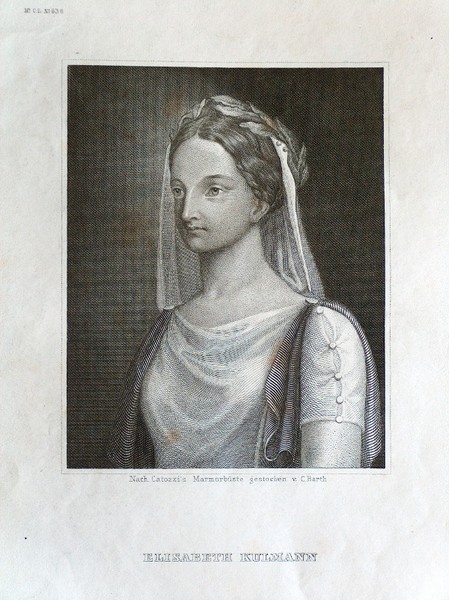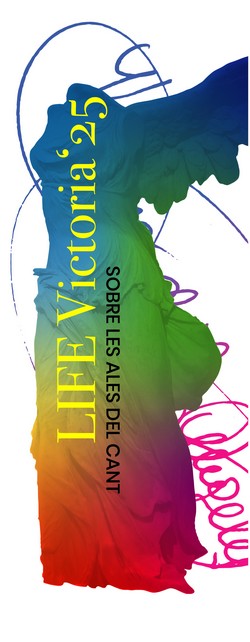Last week of the series in collaboration with the Master's Degree of Lied-ESMUC. Alba Quinquillà presents Die letzten Blumen starben, from Schumann's Sieben Lieder von Elisabeth Kulmann, Op 104. She chose the version with Juliane Banse and Graham Johnson to share with us. Thank you very much, Alba!

Retrat d'Elisabeht Kulmann - C.Barth
In the spring of 1851, Robert Schumann wrote a series of seven songs based on poems by a young writer: Elisabeth Kulmann. A cycle in which we discover some scenes and experiences of the young poet through the prism of the German composer.
The circumstances of Kulmann's life - an extremely talented girl in the field of the humanities - probably impressed the composer, just as the fact that she prematurely died at the age of 17. Apparently, the life of the writer was not easy. A fragile health did not accompany her, and neither to his family. Her mother was ill - which it can be deduced in the first poem of the cycle - and so much his father – a retired military man – and her brothers, who died before her. All this, however, did not prevent her from having a prodigious career for a 17-year-old girl. She learned to speak eleven languages and wrote more than a thousand verses during his short life, some of them published with great success. All these ingredients fueled, supposedly, an admiration for the writer by Robert Schumann. It seems that the composer, when discovering Kulmann's production, felt the responsibility of making it known to the German public.
Schumann, on the other hand, at that time, already suffered serious mental disorders. Disorders that later made him impossible the artistic creation and that in the year 1856 would take the life to him. It does not seem strange that these texts, written from a special sensitivity and with the experience of the pain generated by the illness and the death of the nearest, seduced a tormented composer. In any case, the last creative years of the composer, framed by his arrival in Düsseldorf in 1851 - where he would be the director of the choir and the orchestra of the Allgemeiner Musikverein - and by his internment in 1854, were especially fruitful. In four years, he completed fifty works of varied genres, from music for keyboard to oratorio, through symphonies, concerts for solo instruments or chamber music. In fact, in 1951 - the year in which he wrote the Kulmann’s cycle - was especially marked by the completion, after ten years, of Goethe's Faust Scenes. Also in that year, he wrote the Symphony No. 4, his first symphonic-choral ballad "Der Königssohn" or several chamber music pieces. And in fact, the same spring in which he composed op. 104, he also dedicated four duets with piano to texts by Kulmann. In this case however, the selection of poems does not mention biographical aspects of the author. Rather they are texts about the nature that are accompanied by a music that desires to describe the innocence of the girl's youth.
In the Schumann's choice of texts, we find some poems in which we see Kulmann's most playful facet, that of the girl who enjoys nature or that is related to other young people. But there are also texts in which Kulmann shows in a raw and simple way solitude, anxiety, misunderstanding, frustration or exhaustion. So, although it is not a cycle that develops a story chronologically, there is some emotional evolution. On the one hand, in the first four texts, several themes of the life of the poetess are addressed. On the other hand, the last three songs, focus on their reflections on death.
At the beginning of each cycle, Schumann added a short text that introduces the piece. The Lied we talk about, "Die lezten Blumen starben" (The last flowers have died) is the sixth of the cycle and is presented as follows:
The circumstances of Kulmann's life - an extremely talented girl in the field of the humanities - probably impressed the composer, just as the fact that she prematurely died at the age of 17. Apparently, the life of the writer was not easy. A fragile health did not accompany her, and neither to his family. Her mother was ill - which it can be deduced in the first poem of the cycle - and so much his father – a retired military man – and her brothers, who died before her. All this, however, did not prevent her from having a prodigious career for a 17-year-old girl. She learned to speak eleven languages and wrote more than a thousand verses during his short life, some of them published with great success. All these ingredients fueled, supposedly, an admiration for the writer by Robert Schumann. It seems that the composer, when discovering Kulmann's production, felt the responsibility of making it known to the German public.
Schumann, on the other hand, at that time, already suffered serious mental disorders. Disorders that later made him impossible the artistic creation and that in the year 1856 would take the life to him. It does not seem strange that these texts, written from a special sensitivity and with the experience of the pain generated by the illness and the death of the nearest, seduced a tormented composer. In any case, the last creative years of the composer, framed by his arrival in Düsseldorf in 1851 - where he would be the director of the choir and the orchestra of the Allgemeiner Musikverein - and by his internment in 1854, were especially fruitful. In four years, he completed fifty works of varied genres, from music for keyboard to oratorio, through symphonies, concerts for solo instruments or chamber music. In fact, in 1951 - the year in which he wrote the Kulmann’s cycle - was especially marked by the completion, after ten years, of Goethe's Faust Scenes. Also in that year, he wrote the Symphony No. 4, his first symphonic-choral ballad "Der Königssohn" or several chamber music pieces. And in fact, the same spring in which he composed op. 104, he also dedicated four duets with piano to texts by Kulmann. In this case however, the selection of poems does not mention biographical aspects of the author. Rather they are texts about the nature that are accompanied by a music that desires to describe the innocence of the girl's youth.
In the Schumann's choice of texts, we find some poems in which we see Kulmann's most playful facet, that of the girl who enjoys nature or that is related to other young people. But there are also texts in which Kulmann shows in a raw and simple way solitude, anxiety, misunderstanding, frustration or exhaustion. So, although it is not a cycle that develops a story chronologically, there is some emotional evolution. On the one hand, in the first four texts, several themes of the life of the poetess are addressed. On the other hand, the last three songs, focus on their reflections on death.
At the beginning of each cycle, Schumann added a short text that introduces the piece. The Lied we talk about, "Die lezten Blumen starben" (The last flowers have died) is the sixth of the cycle and is presented as follows:
"A poem full of the presentiment of death, probably dating from the last year of her life. Next to her ‘hut’ there was a little garden, in which year after year she grew flowers. There was also a poplar nearby."
As the comment of the composer puts forward, Kulmann's poem reveals her awareness that she would soon die. She tells how she spots the last flowers in her garden and asks: If I am not sweet like a rose or as strong as a poplar, and they fade when winter comes, why should I not disappear?
Schumann draws the state of deep pain of the protagonist with slow, syllabic melodies, a paused pulse and a reduced intervall range. It seems, even, that he wants to imitate the speech. The accompaniment of the piano is practically minimalist, it has the necessary movement to draw a heavy atmosphere in which there is no sense of dynamism. He only dares to break the line of the melody slightly when the fateful question is asked: if they leave, why do not I? In some way, it seems that this Lied wants to describe a deep sadness or, almost, a depressive state, in which the movements are reduced to a minimum. As if each step, or a forward look would require an energy that is no longer able to access for her. But, despite a constant awareness of the proximity of death, there is also a global sense of peace.
Schumann draws the state of deep pain of the protagonist with slow, syllabic melodies, a paused pulse and a reduced intervall range. It seems, even, that he wants to imitate the speech. The accompaniment of the piano is practically minimalist, it has the necessary movement to draw a heavy atmosphere in which there is no sense of dynamism. He only dares to break the line of the melody slightly when the fateful question is asked: if they leave, why do not I? In some way, it seems that this Lied wants to describe a deep sadness or, almost, a depressive state, in which the movements are reduced to a minimum. As if each step, or a forward look would require an energy that is no longer able to access for her. But, despite a constant awareness of the proximity of death, there is also a global sense of peace.
Die letzten Blumen starben
"Ein Gedicht voll trüber Todesahnung, wohl aus ihrem letzten Lebensjahr. Sie hatte neben ihrer „Hütte“ ein kleines Gärtchen, in dem sie Jahraus, Jahrein, Blumen pflegte. Auch eine Pappel stand in der Nähe."
Die letzten Blumen starben,
Längst sank die Königin
Der warmen Sommermonde,
Die holde Rose hin!
Du hehre Georgine,
Erhebst nicht mehr dein Haupt!
Selbst meine hohe Pappel
Seh ich schon halb entlaubt.
Bin ich doch weder Pappel,
Noch Rose, zart und schlank,
Warum soll ich nicht sinken,
Da selbst die Rose sank?
Längst sank die Königin
Der warmen Sommermonde,
Die holde Rose hin!
Du hehre Georgine,
Erhebst nicht mehr dein Haupt!
Selbst meine hohe Pappel
Seh ich schon halb entlaubt.
Bin ich doch weder Pappel,
Noch Rose, zart und schlank,
Warum soll ich nicht sinken,
Da selbst die Rose sank?
The last flowers have died,
The fair rose, queen
Of the warm summer months,
Has long since gone to rest!
You, gracious dahlia,
No longer raise your head!
Even my tall poplar
Has lost half of its flowers.
And I, who am neither poplar,
Nor delicate slender rose,
Why should I not fade,
If even roses fade?
The fair rose, queen
Of the warm summer months,
Has long since gone to rest!
You, gracious dahlia,
No longer raise your head!
Even my tall poplar
Has lost half of its flowers.
And I, who am neither poplar,
Nor delicate slender rose,
Why should I not fade,
If even roses fade?
Translations by Richard Stokes, author of The Book of Lieder (Faber, 2005)















Comments powered by CComment